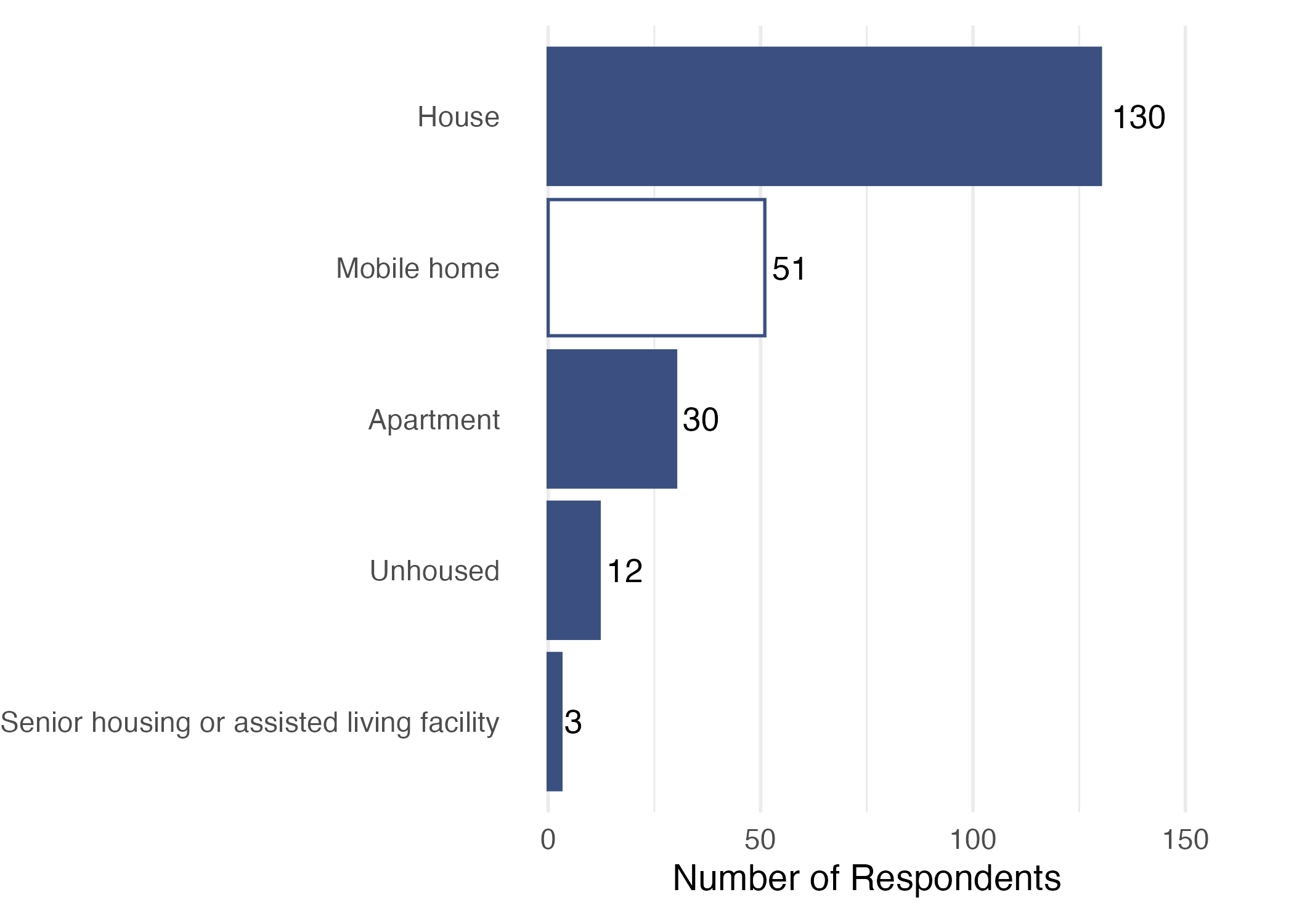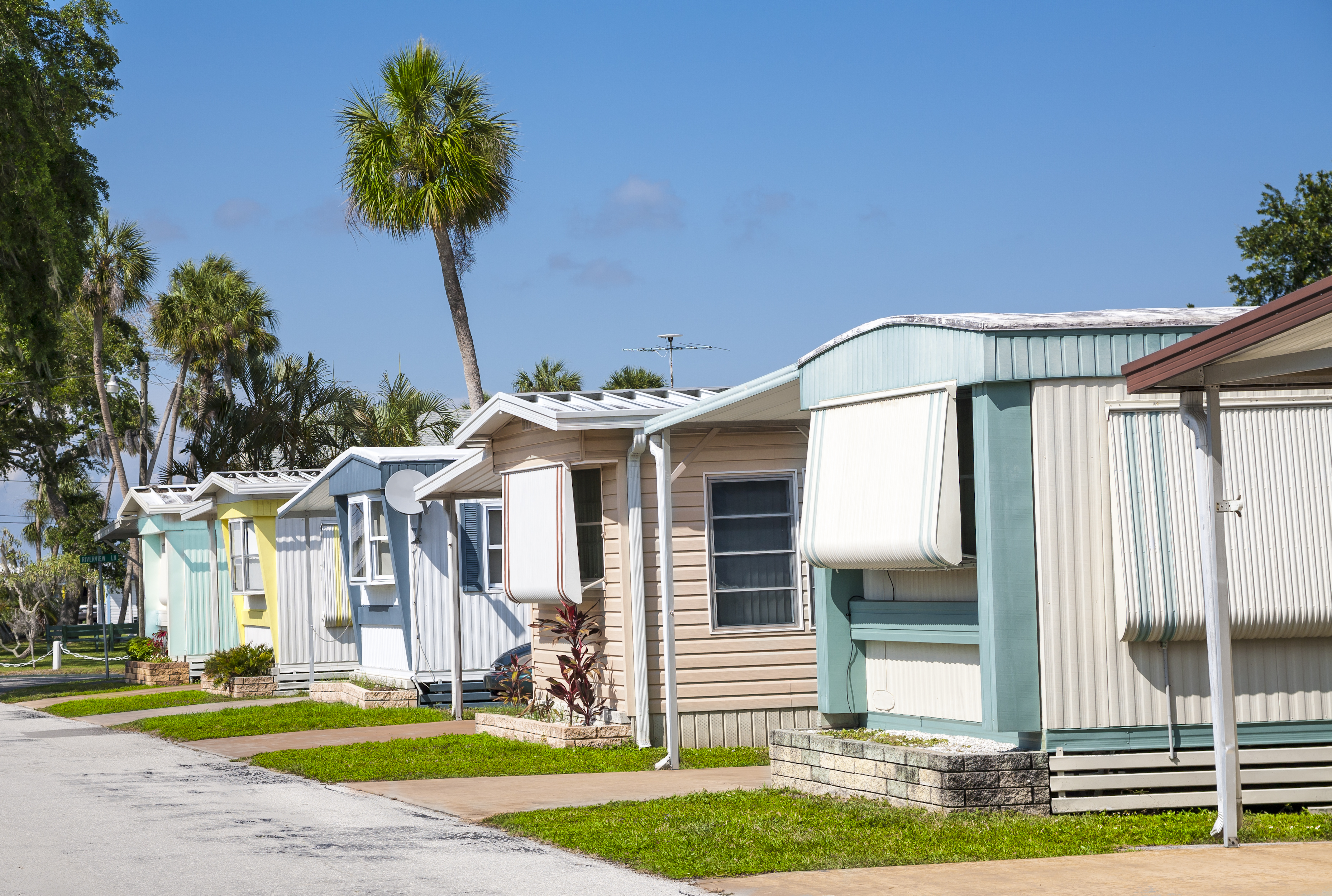About mobile home residents in Lake County
Lake County data show that in 2022 there were nearly 7,400 permitted and occupied mobile or manufactured homes, including 1,473 newly built that year. Mobile or manufactured homes can be an economical alternative to buying or renting a “stick built” home. Most mobile homes are in established “park” communities with water, sewer, and other utilities; an unknown but significant number are located on private property.
Older mobile homes are less likely to meet current standards for energy efficiency, less likely to have reliable air conditioning and heating systems, and residents may not be able to afford to use these inefficient systems during extreme heat and cold events.
Vulnerability to climate-driven events
Residents of mobile and manufactured homes are vulnerable to extreme heat, wildfires, and other climate-driven events (CDE)s for a variety of reasons.
- Structural vulnerability- Many manufactured homes, especially older ones, are built with lightweight materials that offer less protection from heat, fire, or wind than site-built homes. Weak anchoring and temporary foundations increase the risk of damage from storms or floods. Poor insulation and limited cooling systems make these homes especially dangerous during extreme heat.
- High exposure to hazards- Manufactured home parks are often located in low-income or rural areas that face greater risk from wildfires. These homes may lack fire defensible space or be built in flood-prone areas without proper elevation.
- Social and economic inequities- Residents often face high energy burdens and may not be able to afford cooling, home upgrades, or backup power. Many can’t relocate due to financial or logistical barriers, especially if the home is no longer mobile. Manufactured homes are frequently underinsured, making disaster recovery more difficult.
- Lack of emergency resources- Residents may have limited access to emergency alerts, transportation, or shelters, especially if they are elderly, disabled, or socially isolated. These communities often lack investments in resilience infrastructure like cooling centers, drainage, or emergency planning.
- Regulatory gaps- Safety standards may be inconsistently enforced, especially for homes built before the 1976 HUD code or in areas with weak oversight. Residents who rent land but own the home may face challenges upgrading safety features.
Who works with this community
Several organizations and agencies in Lake County, California, provide services that support mobile home residents. The California Department of Housing and Community Development’s Mobilehome Assistance Center offers guidance on resident rights, complaints, and legal protections. Locally, the Lake County Community Development Department administers housing and rehabilitation programs that may benefit mobile home communities. Legal Services of Northern California provides free legal aid for housing issues, including habitability and eviction. Organizations like North Coast Energy Services and Habitat for Humanity Lake County offer home repair, weatherization, and energy assistance programs, which are often accessible to mobile home residents. Additionally, the USDA Rural Development program provides grants and low-interest loans for home repairs, including for manufactured homes.
Highlights from the CHARM surveys and interviews
51 survey respondents (22%) and 5 interviewees (8%) responded that they in a mobile home.
Selected survey findings
The breakdown by housing status from survey respondents was as follows:

Respondents living in mobile homes more frequently reported lacking critical resources during Public Safety Power Shutoffs (PSPS) compared to those in other housing types. Notably:
- 33.3% of mobile home residents reported needing help making their home more comfortable in high heat, compared to 26.7% of non-mobile home residents.
A higher proportion also lacked:
- A place to cool off (23.5% vs. 14.4%)
- A place to breathe clean air (21.6% vs. 17.8%)
Across most categories, mobile home residents showed equal or greater needs, highlighting greater vulnerability to extreme heat and limited access to resilience resources during outages.
Community voices
"It's awful to see that during the hot streaks or the cold streaks, [seniors in mobile homes] live without turning on their units because they can't afford the bill, they would rather freeze."
"Since we're such a high fire zone, and the fires move so fast, and a lot of these people, you know, stay in the mobile homes, and so they go up so fast that sometimes you don't have time to get out without getting burned. So if they had something like a blanket, they could wrap around and get out of their house ... I mean, do you think somebody in a walker? How fast do you think they're going to be able to walk to get out of a fire, out of a mobile home?"
[Interviewer] "So, how do you stay cool? It's mostly the fans?"
[Interviewee] "With the fans. RVs are hot, like, like a oven."
Building resilience for mobile home residents
Identify and engage mobile home communities
- Map mobile/manufactured home parks and communities, especially those in flood zones, fire-prone areas, or extreme heat regions to facilitate outreach, preparedness, and response activities.
- Establish direct communication channels with park managers, residents’ associations, Tribal housing programs, and community leaders.
- Involve residents in planning and decision-making to ensure culturally and contextually relevant solutions.
Improve risk communication and preparedness
- Provide early warning alerts via text, door-to-door outreach, and multilingual materials.
- Offer preparedness workshops focused on low-cost steps to reduce risk (e.g., shade structures, air filtration, emergency kits).
- Develop trusted messenger networks, including community health workers, promotores, or Tribal liaisons.
Retrofit and harden homes
- Create, expand, or facilitate access to grant and loan programs for structural retrofits (e.g., roof reinforcement, insulation, window shading, tie-down systems).
- Distribute guides to residents on how to improve housing resilience.
- Support collective purchasing or installation of mobile-friendly solar or battery systems and communal shade structures.
Expand resilient infrastructure and services
- Support the development of resilience centers near mobile home communities.
- Improve drainage, water, and septic systems in parks vulnerable to flooding or heat-related breakdown.
- Integrate manufactured housing needs into county and Tribal hazard mitigation plans.
>> People experiencing homelessness
<< People who are disabled, homebound, or use medical equipment

